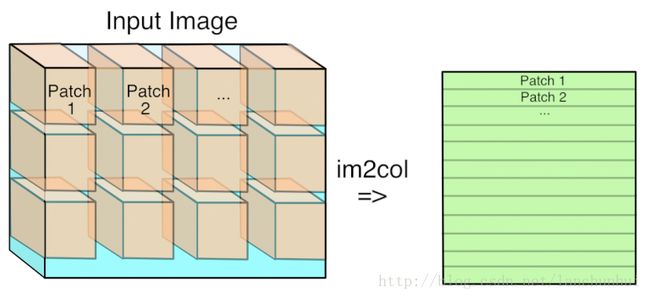卷积计算代码实现
问题
写代码实现卷积操作
问题解答
有两种方式实现,一种是通过滑动窗口的方式,一种是通过转化为矩阵乘法的方式, 后者比前者执行速度快许多
将卷积运算转化为矩阵乘法,从乘法和加法的运算次数上看,两者没什么差别,但是转化成矩阵后,运算时需要的数据被存在连续的内存上,这样访问速度大大提升(cache),同时,矩阵乘法有很多库提供了高效的实现方法,像BLAS、MKL等,转化成矩阵运算后可以通过这些库进行加速。
缺点呢?这是一种空间换时间的方法,消耗了更多的内存——转化的过程中数据被冗余存储。
还有两张形象化的图片帮助理解:
代码实现
# 简化计算,假设batchsize为1, 卷积核个数为1
import numpy as np
# 滑窗实现
class Conv2d(object):
def __init__(self, img, c_out, kernel, stride, padding):
self.img = img
self.c_out = c_out
self.kernel = kernel
self.stride = stride
self.padding = padding
def conv(self):
input_c, input_h, input_w = self.img.shape
# out_ = []
# for c_o in range(self.c_out):
output = []
#分通道划窗计算
for c in range(input_c):
out = self.compute_conv(input[c], self.kernel[c])
output.append(out)
# out_.append(sum(output))
return sum(output)
def compute_conv(self, input_c, kernel_c):
k, _ = kernel_c.shape
h, w = input_c.shape
if self.padding == "valid":
out_h = (h - k)//self.stride + 1
out_w = (w - k)//self.stride + 1
pad_h, pad_w = 0, 0
if self.padding == "same":
out_h, out_w = h, w
pad_w = (w*(self.stride-1)+k-self.stride)//2
pad_h = (h*(self.stride-1)+k-self.stride)//2
if self.padding == "full":
pad_w = k-1
pad_h = k-1
out_h = (w + 2*pad_h - k) // self.stride + 1
out_w = (h + 2*pad_w - k) // self.stride + 1
input_padding = np.zeros((h+pad_h*2, w+pad_w*2))
input_padding[pad_h:pad_h+h, pad_w:pad_w+w] = input_c
out = np.zeros((out_h, out_w))
for i in range(0, out_h):
for j in range(0, out_w):
out[i, j] = np.sum(input_padding[i*self.stride:i*self.stride+k, j*self.stride:j*self.stride+k] * kernel_c)
return out
# 矩阵实现
class Conv2dMatrix():
def __init__(self, img, c_out, kernel, stride, padding):
self.img = img
self.c_out = c_out
self.kernel = kernel
self.stride = stride
self.padding = padding
def conv(self):
c, h, w = self.img.shape
c_k, k, _ = self.kernel.shape
if self.padding == "same":
out_h, out_w = h, w
pad_w = (self.stride*(w-1) - w + k) // 2
pad_h = (self.stride*(h-1) - h + k) // 2
if self.padding == "valid":
out_h = (h-k) // self.stride + 1
out_w = (w-k) // self.stride + 1
pad_h = 0
pad_w = 0
if self.padding == "full":
pad_w = k - 1
pad_h = k - 1
out_h = (h + 2*pad_h - k) // self.stride + 1
out_w = (w + 2*pad_w - k) // self.stride + 1
img_padding = np.zeros((c, h+2*pad_h, w+2*pad_w))
img_padding[:, pad_h:pad_h+h, pad_w:pad_w+w] = self.img
feature_matrix = np.zeros((out_w*out_h, c_k*k*k))
patch = 0
for i in range(out_h):
for j in range(out_w):
feature_patch = img_padding[:, i*self.stride:i*self.stride+k, j*self.stride:j*self.stride+k]
feature_matrix[patch] = feature_patch.flatten()
patch += 1
kernel_matrix = self.kernel.reshape(c_k*k*k, 1)
return np.dot(feature_matrix, kernel_matrix).reshape(out_h, out_w)
input = np.array([[[1, 2, 3, 4, 5, 6, 7]]*7]*3)
input = input.reshape(-1, input.shape[1], input.shape[2])
kernel = np.array([[[0, 1, 1], [1, 0, 1], [1, 0, 0]]]*3)
kernel = kernel.reshape(-1, kernel.shape[1], kernel.shape[2])
conv2d = Conv2d(input, 1, kernel, 1, padding="full")
out = conv2d.conv()
print(out)
conv2d_m = Conv2dMatrix(input, 1, kernel, 1, padding='full')
out = conv2d_m.conv()
print(out)
参考资料
1、im2col:将卷积运算转为矩阵相乘
2、面试基础–深度学习 卷积及其代码实现
3、 卷积前向计算代码实现


